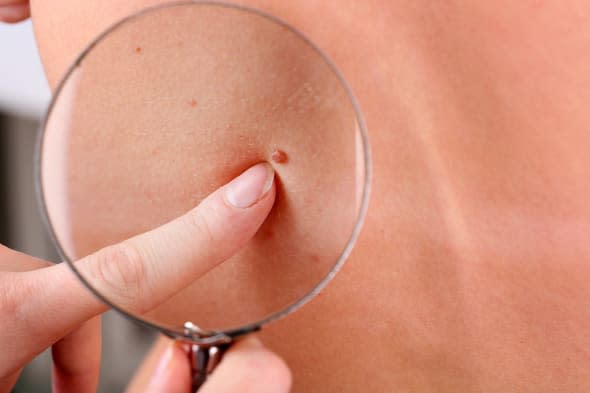Skin cancer - how to recognise the signs

Pic: Shutterstock
A bit of sunshine is always welcome here in Britain, but during the summer months when the sun's heat is at its peak, skin cancer is a real risk. According to Cancer Research, skin cancer of the malignant melanoma variety is now the fifth most common cancer in the UK, and the numbers are growing.
It is always wise to take precautions if you're out in the sun, but it's equally important to know how to spot a potential problem.
Related Searches
Types of skin cancer
The three most common types of skin cancer are Basal cell carcinoma (BCC), squamous cell carcinoma (SCC) and malignant melanoma.
The first-named accounts for around 75 per cent of all skin cancers in the UK, and if treated early, is typically completely cured. Left untreated, however, it can grow and spread to the deeper layers of skin and even occasionally the bones. In some instances, a BCC may return in the same area of skin even after treatment, in what is called a 'local recurrence'.
Squamous cell carcinoma occurs in the outer layer of the skin, and this slow-growing cancer is usually treated simply and effectively. Malignant melanoma, on the other hand, can grow quickly, and early treatment is necessary.
Several rare types of non-melanoma skin cancer can occur, including Merkel cell carcinoma, Kaposi's sarcoma, cutaneous T-cell lymphoma and sarcoma, but these account for less than three per cent of skin cancers in the UK.
Signs of non-melanoma skin cancer
Thankfully, the symptoms of non melanoma cancer are typically easy to spot. Most people are aware of the way their skin normally looks and can spot any unusual changes, but if you work outside a lot or sunbathe, exposing your skin to the sun for long periods of time, you should pay particular attention. If possible get your partner or a family member to check your back and other areas that you cannot check yourself.
These benign types of cancer often appear as a spot or sore that does not heal within four weeks, or that continues to itch, scab, hurt or bleed for that same period of time. If the skin has broken down and become ulcerated without healing within four weeks, it's another sign of a problem.
To check for BCCs, look for small, shiny, pink or red lumps, or red scaly patches. Typically these will appear on the face, scalp, ears, hands, shoulders and back, although not exclusively, and if left untreated, they will often become crusty, bleed or develop into an ulcer.
SCCs are commonly seen as pink lumps, often with a hard or scaly surface. Sometimes they are tender, although not always, and they will often bleed easily or turn into an ulcer. The face, neck, lips, ears, hands, shoulders, arms and legs are the most common places for SCCs to occur.
Signs of melanoma
These malignant cancers occur as moles, and though they can develop anywhere on the body, they most commonly affect men on the back, and women on the legs.
It is essential that you keep a close eye on your moles so that you can get them checked out if anything changes. Caught early, most malignant melanomas can simply be removed under local anaesthetic.
New moles or a change in your skin are a clear indication that there's a problem, but existing moles can also signify a melanoma. A mole that has grown in size, changed shape or developed an irregular edge, or one that is no longer symmetrical is a potential problem, as is a change in the colour of the mole - either becoming darker, patchy or multi-shaded.
Cancer Research advises that moles with three or more different shades of black or brown are especially likely to point to melanoma so keep a close watch for any changes. Any mole that is painful or itchy, bleeds or becomes crusty or inflamed could also signal that a melanoma has developed.
%VIRTUAL-AFCSponserAds%
Melanoma can also develop in the eye, and it may be visible as a dark spot in the iris. They can also grow inside the eye, however, in which case there will be no visible sign, but changes in your eyesight and regular routine eye examinations may spot a problem.
As with any cancer, the key to successful treatment is early diagnosis, so if you have noticed a change in your skin or are worried about a particular mole, do not dismiss it. Book an appointment with your GP and be safe, not sorry.
Have you had skin cancer? Tell us about your experience below...




